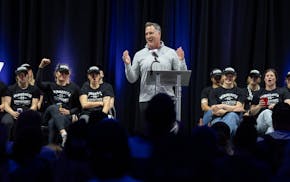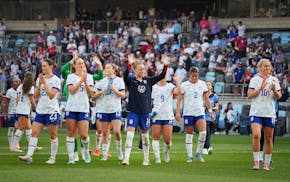Tony Oliva shuffled into his living room to thumb through some photo albums. Then he entered his den, walked by the pool table, opened a cabinet and pulled out a box.
"Here, go through this," he said to his Wednesday visitor while reaching for more boxes.
The visitor, me, felt guilty. It was my question that had the Hall of Famer turning his home upside down while looking for a photo of him with former Minneapolis Miller Willie Mays. We found pictures of Oliva with darn near everyone else. Ted Williams. Ernie Banks. Orlando Cepeda. Roy Campanella. Ferguson Jenkins. All his Twins teammates. Even one with future president George Bush and at a large dinner gathering that included O.J. Simpson.
"I can't believe this," said the 85-year-old Oliva, now sitting on the floor between the cabinet and pool table, flipping through photographs.
Oliva played in the American League while Mays played in the National League. But the two had become acquaintances through years of All-Star Games and Old Timers' games. And he's sure he has photographic proof somewhere in his Bloomington home. I stopped him from going into the basement to continue the search.
Mays passed away Tuesday at age 93, two days before a Negro Leagues tribute game is scheduled to be played in Birmingham, Ala., where he played for the Black Barons before signing with the New York Giants. Oliva was home when a Twins official called to inform him of Mays' passing. He knew Mays had been ailing and had been in contact with Cepeda for updates.
Mays, his favorite player, had been on his mind.
"I've had a chance to see a lot of players. I've been in baseball 60 years," Oliva said. "There were a lot of good players in my era. You had [Roberto] Clemente, Hank Aaron, the Mickey Mantles. You pick one out of all those great players, and it's not fair. But, for me, Willie was number one. Willie did everything. He was special in everything."
Minnesotans know this better than most. Mays was here for 35 games in 1951 as a member of the Millers. Just 35 games, but they were memorable. The story of the best all-around player in baseball history can't be told without including his Millers exploits.
Mays lived at 3616 4th Av. S. in Minneapolis, just a short walk away from Nicollet Park, home of the Millers. He already had Giants manager Leo Durocher drooling over him during spring training but was not allowed to break camp with the team. So Mays was sent to their affiliate in Minneapolis.
He hit his first homer in the third game. In the fifth game, he threw out a runner at home plate then scored the winning run in the 10th inning. In the seventh game, he scored the winning run in the 11th. In those 35 games, Mays batted a ridiculous .477 with eight home runs, 38 runs scored, 30 RBI, a .799 slugging percentage and was on a 16-game hitting streak when Durocher called him up.
Millers fans were so incensed that Giants owner Horace Stoneham wrote a letter to the Minneapolis Sunday Tribune addressing the move. "Merit must be recognized," he explained.
Mays left the Millers and headed for NL Rookie of the Year honors that season. He appeared in exhibition games in Minneapolis in following seasons. Then he returned for the 1965 All-Star Game, which was held at Metropolitan Stadium. He played despite a bruised hip, and he played the entire game. "After I put a guy like Willie Mays in the lineup, why should I replace him?" said NL manager, and future Twins manager, Gene Mauch.
This was back when each league wanted to beat the other and before managers made sure everyone played and received an orange slice following games.
Oliva, one of six Twins on the AL team, chuckled as he remembered that Mays took Milt Pappas deep for a leadoff homer and was 1-for-3 with two walks.
Not long after Mays' departure for the big leagues in '51, local officials began trying to bring Major League Baseball to the Twin Cities. Fans didn't want a farm team anymore. So perhaps Mays' time here added fuel to the movement.
Mays went on to belt 660 career homers, which is still sixth all-time. That aged well despite the juiced baseballs and the PED era. Mays missed most of 1952 and all of 1953 while on military duty, or he might have made a run at 700 homers. Or even Babe Ruth's 714, which was the record at that time.
Another 40 or more home runs would not have altered Mays' status as the best pound-for-pound player ever. Millers fans knew what the Giants were getting. Oliva was sure of Mays' legacy, as we put his house back together after rummaging through photos for over an hour -- for a photo that was never found.
"He was easy to talk to and liked to talk about games in the past," Oliva said. "He was the best player I've ever seen play. There is no one comparable."
Neal: Trade season is here ... and now it's time for the Twins to act

Neal: Ken Klee finds the right formula at the right time for the Frost

Neal: Girma returns to United States national team and rewards fans with her classiness

Neal: It's time to see what A-Rod and Marc Lore can do



